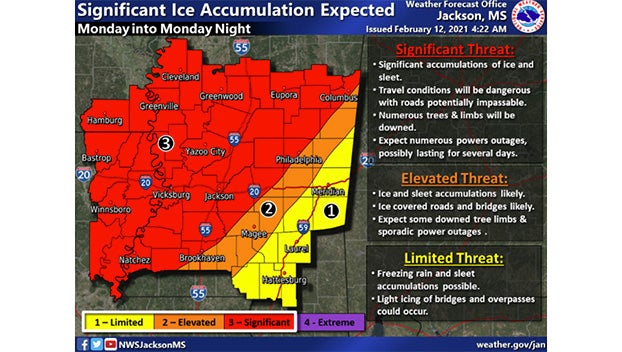Winter Storm Advisory for much of Mississippi Monday. Weather Service says now is time to prepare.
Published 10:42 am Friday, February 12, 2021
The National Weather Service in Jackson says now is the time to prepare for a winter storm that will move across the region Monday into Monday night.
Much of western and northern Mississippi is expected to see significant amounts of sleet and ice as the storm moves across the area.
“A winter storm with significant accumulations of freezing rain and sleet is expected to impact the area Monday into Monday night. Dangerous travel conditions are likely along with power outages. Now is the time to begin making preparations!” NWS in Jackson reported on Twitter.
A winter storm with significant accumulations of freezing rain and sleet is expected to impact the area Monday into Monday night. Dangerous travel conditions are likely along with power outages. Now is the time to begin making preparations! pic.twitter.com/tXxdvD2h3W
— NWS Jackson MS (@NWSJacksonMS) February 12, 2021
Now is the time to prepare, weather officials say.
What to do before the storm arrives:
- Prepare your home to keep out the cold with insulation, caulking and weather stripping. Learn how to keep pipes from freezing. Install and test smoke alarms and carbon monoxide detectors with battery backups.
- Pay attention to weather reports and warnings of freezing weather and winter storms.
- Sign up for your community’s warning system. The Emergency Alert System (EAS) and National Oceanic and Atmospheric Administration (NOAA) Weather Radio also provide emergency alerts. Sign up for email updates about coronavirus from the Centers for Disease Control and Prevention (CDC).
- Gather supplies in case you need to stay home for several days without power. Keep in mind each person’s specific needs, including medication. Remember the needs of your pets. Have extra batteries for radios and flashlights. If you are able to, set aside items like soap, hand sanitizer that contains at least 60 percent alcohol, disinfecting wipes, and general household cleaning supplies that you can use to disinfect surfaces you touch regularly.
- Make sure flashlights are easily accessible.
- Fill your gas tank.
- Bring your pets and plants inside.
- Create an emergency supply kit for your car. Include jumper cables, sand, a flashlight, warm clothes, blankets, bottled water and non-perishable snacks. Keep a full tank of gas.Remember that not everyone can afford to respond by stocking up on necessities. For those who can afford it, making essential purchases and slowly building up supplies in advance will allow for longer time periods between shopping trips. This helps to protect those who are unable to procure essentials in advance of the pandemic and must shop more frequently. In addition, consider avoiding WIC-labeled products so that those who rely on these products can access them.
Being prepared allows you to avoid unnecessary excursions and to address minor medical issues at home, alleviating the burden on urgent care centers and hospitals. - Learn the signs of, and basic treatments for, frostbite and hypothermia.If you are sick and need medical attention, contact your healthcare provider for further care instructions and shelter in place, if possible. If you are experiencing a medical emergency, call 9-1-1 and let the operator know if you have, or think you might have, COVID-19. If possible, put on a mask before help arrives.
- Learn the symptoms of COVID-19 and follow CDC guidance.
- Frostbite causes loss of feeling and color around the face, fingers and toes.Signs: Numbness, white or grayish-yellow skin, firm or waxy skin. Actions: Go to a warm room. Soak in warm water. Use body heat to warm. Do not massage or use a heating pad.
- Hypothermia is an unusually low body temperature. A temperature below 95 degrees is an emergency.Signs: Shivering, exhaustion, confusion, fumbling hands, memory loss, slurred speech or drowsiness. Actions: Go to a warm room. Warm the center of the body first—chest, neck, head and groin. Keep dry and wrapped up in warm blankets, including the head and neck.






